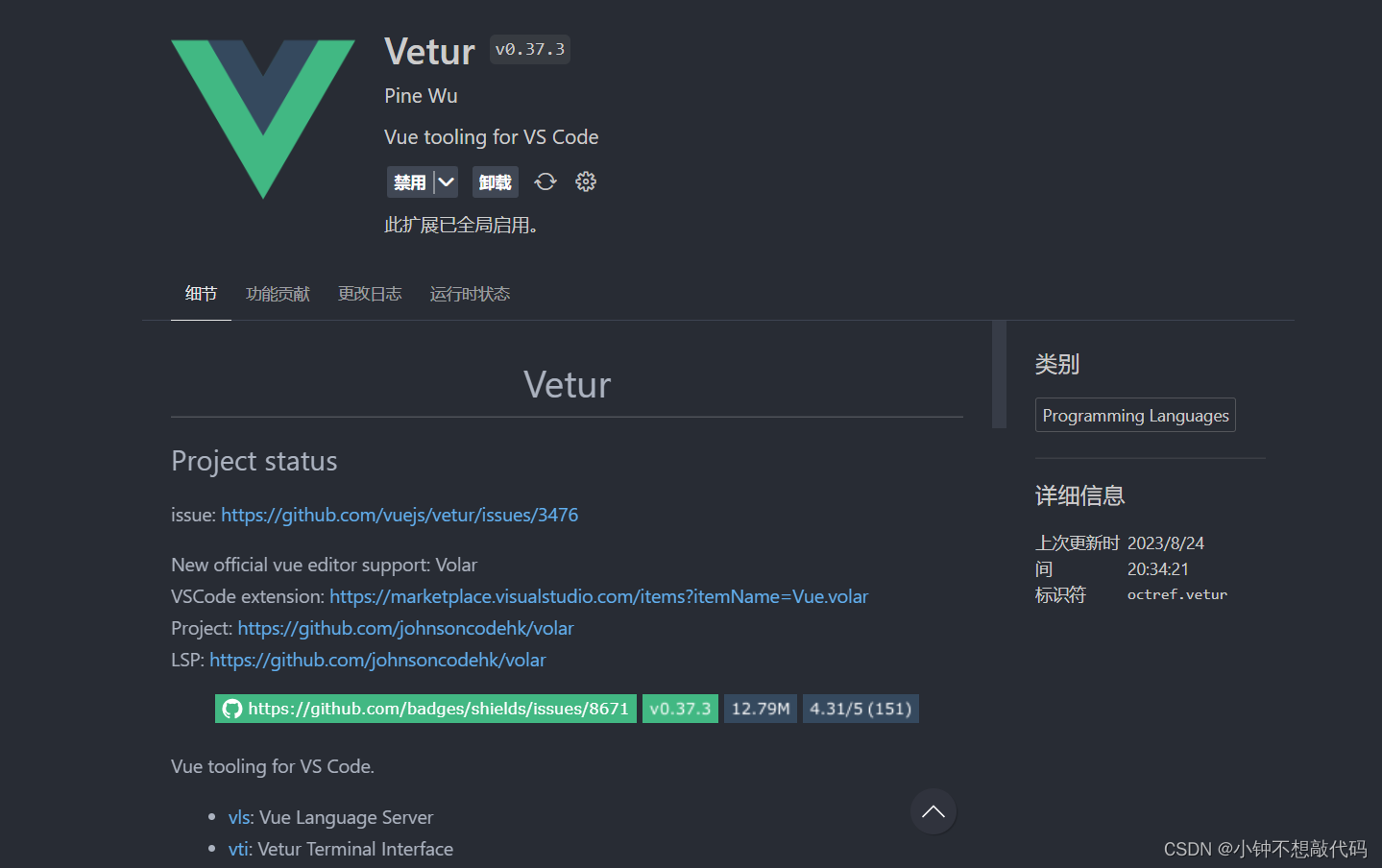一、今日目标
1.生命周期
- 生命周期介绍
- 生命周期的四个阶段
- 生命周期钩子
- 声明周期案例
2.工程化开发入门
- 工程化开发和脚手架
- 项目运行流程
- 组件化
- 组件注册
二、Vue生命周期
思考:什么时候可以发送初始化渲染请求?(越早越好)什么时候可以开始操作dom?(至少dom得渲染出来)
Vue生命周期:就是一个Vue实例从
创建
到
销毁
的整个过程。
生命周期四个阶段:
① 创建 ② 挂载 ③ 更新 ④ 销毁
1.创建阶段:
创建响应式数据
2.挂载阶段:
渲染模板
3.更新阶段:
修改数据,更新视图
4.销毁阶段:
销毁Vue实例
[外链图片转存失败,源站可能有防盗链机制,建议将图片保存下来直接上传(img-DACIFzt7-1693057054325)(assets/1682065937815.png)]
三、Vue生命周期钩子
Vue生命周期过程中,会自动运行一些函数,被称为【生命周期钩子】→ 让开发者可以在【特定阶段】运行自己的代码
![[外链图片转存失败,源站可能有防盗链机制,建议将图片保存下来直接上传(img-dDd6J4Lc-1693057054327)(assets/1682066040295.png)]](https://img-blog.csdnimg.cn/e0f9509a3e0446f1a0edb887fede08e1.png)
<!DOCTYPEhtml><htmllang="en"><head><metacharset="UTF-8"><metahttp-equiv="X-UA-Compatible"content="IE=edge"><metaname="viewport"content="width=device-width, initial-scale=1.0"><title>Document</title></head><body><divid="app"><h3>{{ title }}</h3><div><button@click="count--">-</button><span>{{ count }}</span><button@click="count++">+</button></div></div><scriptsrc="https://cdn.jsdelivr.net/npm/vue@2/dist/vue.js"></script><script>const app =newVue({el:'#app',data:{count:100,title:'计数器'},// 1. 创建阶段(准备数据)beforeCreate(){
console.log('beforeCreate 响应式数据准备好之前',this.count)},created(){
console.log('created 响应式数据准备好之后',this.count)// this.数据名 = 请求回来的数据// 可以开始发送初始化渲染的请求了},// 2. 挂载阶段(渲染模板)beforeMount(){
console.log('beforeMount 模板渲染之前', document.querySelector('h3').innerHTML)},mounted(){
console.log('mounted 模板渲染之后', document.querySelector('h3').innerHTML)// 可以开始操作dom了},// 3. 更新阶段(修改数据 → 更新视图)beforeUpdate(){
console.log('beforeUpdate 数据修改了,视图还没更新', document.querySelector('span').innerHTML)},updated(){
console.log('updated 数据修改了,视图已经更新', document.querySelector('span').innerHTML)},// 4. 卸载阶段beforeDestroy(){
console.log('beforeDestroy, 卸载前')
console.log('清除掉一些Vue以外的资源占用,定时器,延时器...')},destroyed(){
console.log('destroyed,卸载后')}})</script></body></html>
四、生命周期钩子小案例
1.在created中发送数据
<!DOCTYPEhtml><htmllang="en"><head><metacharset="UTF-8"><metahttp-equiv="X-UA-Compatible"content="IE=edge"><metaname="viewport"content="width=device-width, initial-scale=1.0"><title>Document</title><style>*{margin: 0;padding: 0;list-style: none;}.news{display: flex;height: 120px;width: 600px;margin: 0 auto;padding: 20px 0;cursor: pointer;}.news .left{flex: 1;display: flex;flex-direction: column;justify-content: space-between;padding-right: 10px;}.news .left .title{font-size: 20px;}.news .left .info{color: #999999;}.news .left .info span{margin-right: 20px;}.news .right{width: 160px;height: 120px;}.news .right img{width: 100%;height: 100%;object-fit: cover;}</style></head><body><divid="app"><ul><liv-for="(item, index) in list":key="item.id"class="news"><divclass="left"><divclass="title">{{ item.title }}</div><divclass="info"><span>{{ item.source }}</span><span>{{ item.time }}</span></div></div><divclass="right"><img:src="item.img"alt=""></div></li></ul></div><scriptsrc="https://cdn.jsdelivr.net/npm/vue@2/dist/vue.js"></script><scriptsrc="https://cdn.jsdelivr.net/npm/axios/dist/axios.min.js"></script><script>// 接口地址:http://hmajax.itheima.net/api/news// 请求方式:getconst app =newVue({el:'#app',data:{list:[]},asynccreated(){// 1. 发送请求获取数据const res =await axios.get('http://hmajax.itheima.net/api/news')// 2. 更新到 list 中,用于页面渲染 v-forthis.list = res.data.data
}})</script></body></html>
2.在mounted中获取焦点
<!DOCTYPEhtml><htmllang="zh-CN"><head><metacharset="UTF-8"><metahttp-equiv="X-UA-Compatible"content="IE=edge"><metaname="viewport"content="width=device-width, initial-scale=1.0"><title>示例-获取焦点</title><!-- 初始化样式 --><linkrel="stylesheet"href="https://cdn.jsdelivr.net/npm/[email protected]/reset.min.css"><!-- 核心样式 --><style>html,
body{height: 100%;}.search-container{position: absolute;top: 30%;left: 50%;transform:translate(-50%, -50%);text-align: center;}.search-container .search-box{display: flex;}.search-container img{margin-bottom: 30px;}.search-container .search-box input{width: 512px;height: 16px;padding: 12px 16px;font-size: 16px;margin: 0;vertical-align: top;outline: 0;box-shadow: none;border-radius: 10px 0 0 10px;border: 2px solid #c4c7ce;background: #fff;color: #222;overflow: hidden;box-sizing: content-box;-webkit-tap-highlight-color: transparent;}.search-container .search-box button{cursor: pointer;width: 112px;height: 44px;line-height: 41px;line-height: 42px;background-color: #ad2a27;border-radius: 0 10px 10px 0;font-size: 17px;box-shadow: none;font-weight: 400;border: 0;outline: 0;letter-spacing: normal;color: white;}body{background: no-repeat center /cover;background-color: #edf0f5;}</style></head><body><divclass="container"id="app"><divclass="search-container"><imgsrc="https://www.itheima.com/images/logo.png"alt=""><divclass="search-box"><inputtype="text"v-model="words"id="inp"><button>搜索一下</button></div></div></div><scriptsrc="https://cdn.jsdelivr.net/npm/vue@2/dist/vue.js"></script><script>const app =newVue({el:'#app',data:{words:''},// 核心思路:// 1. 等input框渲染出来 mounted 钩子// 2. 让input框获取焦点 inp.focus()mounted(){
document.querySelector('#inp').focus()}})</script></body></html>
五、工程化开发和脚手架
1.开发Vue的两种方式
- 核心包传统开发模式:基于html / css / js 文件,直接引入核心包,开发 Vue
- 工程化开发模式:基于构建工具(例如:webpack)的环境中开发Vue
![[外链图片转存失败,源站可能有防盗链机制,建议将图片保存下来直接上传(img-RTuvPyF3-1693057054329)(assets/1682090039070.png)]](https://img-blog.csdnimg.cn/12f5f16c1e3f463aa42266e5a67c4e7e.png)
- 工程化开发模式优点:- 提高编码效率,比如使用JS新语法、Less/Sass、Typescript等通过webpack都可以编译成浏览器识别的ES3/ES5/CSS等
- 工程化开发模式问题:- webpack配置不简单- 雷同的基础配置- 缺乏统一的标准
为了解决以上问题,所以我们需要一个工具,生成标准化的配置
2.脚手架Vue CLI
基本介绍:
- Vue CLI 是Vue官方提供的一个全局命令工具
- 可以帮助我们快速创建一个开发Vue项目的标准化基础架子。【集成了webpack配置】
好处:
- 开箱即用,零配置
- 内置babel等工具
- 标准化的webpack配置
使用步骤:
- 全局安装(只需安装一次即可)
yarn global add @vue/cli 或者 npm i @vue/cli -g - 查看vue/cli版本
vue --version - 创建项目架子
vue create project-name #(项目名不能使用中文) - 启动项目
yarn serve 或者 npm run serve (命令不固定,找package.json)
六、项目目录介绍和运行流程
1.项目目录介绍
![[外链图片转存失败,源站可能有防盗链机制,建议将图片保存下来直接上传(img-KtCQK5se-1693057054330)(assets/1682092148521.png)]](https://img-blog.csdnimg.cn/10f37cfe79bb4468b1c9ba9bbd97173e.png)
虽然脚手架中的文件有很多,目前咱们只需人事三个文件即可
main.js 入口文件App.vue App根组件index.html 模板文件
2.运行流程
![[外链图片转存失败,源站可能有防盗链机制,建议将图片保存下来直接上传(img-jHbLh6fy-1693057054331)(assets/1682094032876.png)]](https://img-blog.csdnimg.cn/a33d66659bad41318127c1e326b022ed.png)
七、组件化开发
- 组件化:一个页面可以拆分成一个个组件,每个组件有着自己独立的
结构、样式、行为 - 好处:便于维护,利于复用 → 提升开发效率
- 组件分类:
普通组件、根组件
比如:下面这个页面,可以把所有的代码都写在一个页面中,但是这样显得代码比较混乱,难易维护。咱们可以按模块进行组件划分
![[外链图片转存失败,源站可能有防盗链机制,建议将图片保存下来直接上传(img-lvJHfnHX-1693057054331)(assets/1682168852372.png)]](https://img-blog.csdnimg.cn/d2ff172cf1b14d3f9b5894f5b7b372a0.png)
八、根组件 App.vue
1.根组件介绍
整个应用最上层的组件,包裹所有普通小组件
![[外链图片转存失败,源站可能有防盗链机制,建议将图片保存下来直接上传(img-MXGMolcu-1693057054332)(assets/1682169131688.png)]](https://img-blog.csdnimg.cn/65ef13bf87824793bfef0fcebe282e1f.png)
2.组件是由三部分构成
- 语法高亮插件

- 三部分构成-
template:结构 (有且只能一个根元素)-script: js逻辑-style: 样式 (可支持less,需要装包) - 让组件支持less(1) style标签,lang=“less” 开启less功能(2) 装包: yarn add less less-loader -D 或者npm i less less-loader -D
九、普通组件的注册使用-局部注册
1.特点:
只能在注册的组件内使用
2.步骤:
- 创建.vue文件(三个组成部分)
- 在使用的组件内先导入再注册,最后使用
3.使用方式:
当成html标签使用即可
<组件名></组件名>
4.注意:
组件名规范 —>
大驼峰命名法
, 如 HmHeader
5.语法:
![[外链图片转存失败,源站可能有防盗链机制,建议将图片保存下来直接上传(img-Imoz189E-1693057054334)(assets/1682227966812.png)]](https://img-blog.csdnimg.cn/fc02ef3d7dd54fc3bf5e8b874a155515.png)
// 导入需要注册的组件// import 组件对象 from '.vue文件路径'import HmHeader from'./components/HmHeader'exportdefault{// 局部注册components:{// '组件名': 组件对象,HmHeader:HmHeaer,
HmHeader // 也可以简写}}
十、普通组件的注册使用-全局注册
1.特点:
全局注册的组件,在项目的任何组件中都能使用
2.步骤
- 创建.vue组件(三个组成部分)
- main.js中进行全局注册
3.使用方式
当成HTML标签直接使用
<组件名></组件名>
4.注意
组件名规范 —>
大驼峰命名法
, 如 HmHeader
5.语法
Vue.component(‘组件名’, 组件对象)
例:
// 导入需要全局注册的组件import HmButton from'./components/HmButton'
Vue.component('HmButton', HmButton)
版权归原作者 小钟不想敲代码 所有, 如有侵权,请联系我们删除。